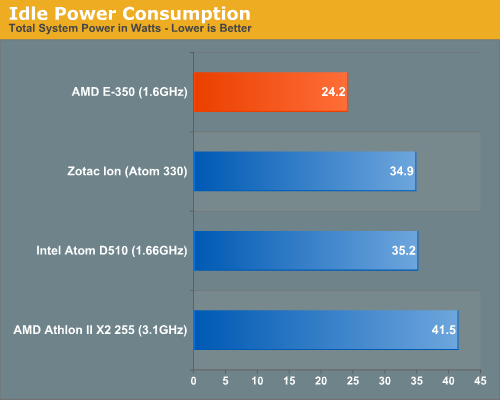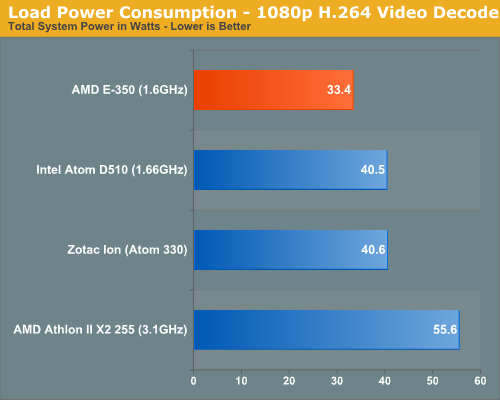The Brazos Review: AMD's E-350 Supplants ION for mini-ITX
by Anand Lal Shimpi on January 27, 2011 6:08 PM ESTPower Consumption: Better than Atom
Power efficiency was a big draw of Atom, but does AMD sacrifice any of that in order to deliver the performance it does with the E-350? To be blunt: no, not at all.
I don’t have any pico PSUs or anything super efficient readily available so don’t expect any of the numbers to be particularly impressive, but what they are is comparable to one another. I hooked up each one of the systems I’d been using to the same PSU and measured power in three conditions: idle, full CPU load (Cinebench 11.5) and while playing a 1080p H.264 video.

Pine Trail and the old ION platform consume just about the same amount of power at idle. The Athlon II system obviously draws more, in this case an increase of 17%. The E-350 uses less than 70% of the power of the Atom D510 system at idle.

Under load the Brazos advantage shrinks a bit but it’s still much lower power than Atom. While playing a H.264 you’re looking at ~83% of the power of an ION system, and 85% under full CPU load.

Say what you will about Intel’s manufacturing process advantage, it’s simply not put to use here with Atom. AMD’s E-350 is higher performing and uses less power than Intel’s 45nm Atom D510. Did I mention it’s built on a smaller die as well?
I wanted to isolate the CP...err APU and look at its power draw exclusively. I ran the same three tests but this time I’m not measuring power at the wall, but rather just power over the ATX12V connector directly to the CPU.
At idle the E-350 APU only requires around 3W of power. That’s actually not as low as I’d expect, especially given that Sandy Bridge is typically down at 4W when fully idle. AMD is apparently not being too aggressive with stopping clocks and gating when fully idle, at least on the desktop Brazos parts.
| Power Consumption Comparison | |||||
| ATX12V Power Draw | Idle | 1080p H.264 Decode | Cinebench 11.5 | ||
| AMD E-350 | 3W | 8W | 9W | ||
| AMD Athlon II X2 255 | 7W | 12W | 47W | ||
Under load, either full CPU or when using the video decode engine, APU power consumption is around 8 - 9W. By comparison, an Athlon II X2 255 will use 12W when decoding video (this doesn’t include the UVD engine in the 890GX doing most of the heavy lifting. The more interesting comparison is what happens when the CPU cores are fully loaded. The E-350 uses 9W running Cinebench 11.5 compared to 47W by the Athlon II X2.










176 Comments
View All Comments
tipoo - Thursday, January 27, 2011 - link
Goodbye, crappy Atom.ssj4Gogeta - Friday, February 4, 2011 - link
@Anand:"Remember that the Atom 330 is a dual-core CPU with SMT (4-threads total) so you’re actually getting 17.2% of four hardware threads used, but 34.4% of two cores."
Why would you say that, when those 4 threads are actually running on the 2 CPU cores? Or is it that the average for the 4 threads can never exceed 50%? Only in that case your doubling of the number makes sense.
ClagMaster - Thursday, January 27, 2011 - link
This is amazing performance for an 18W processor if you really think hard about it.This rig will beat my Athlon 1700+/KT266A/DDR-266/GeForce 4200 rig I had six years ago.
AMD will sell a lot of these Bobcats after the final bugs are worked out.
Dark_Archonis - Friday, January 28, 2011 - link
No, no it's not. Intel will very soon release 17W ULV Sandy Bridge CPUs.Even a current ULV Arrandale CPU will take out a Brazos in terms of CPU performance.
Kiijibari - Friday, January 28, 2011 - link
Hahaha ... attacking tiny Zacate with a Sandy Bridge ... yes it may have triple or quadruple performance, but so will be it's price ^^Shadowmaster625 - Friday, January 28, 2011 - link
yeah and the tray price will be $188 per cpu, in qty's of 1000. Haha good luck with that.djgandy - Friday, January 28, 2011 - link
Yes I am looking forward to ULV Sandybridge. I still have a Core Duo CULV which is starting to show its age. I'm sure it is still way faster than Atom and Zacate.It may cost more but you'll have 2-3 times the CPU performance with SB. Plus it should have dedicated video decode.
coconutboy - Friday, January 28, 2011 - link
You're only talking about the speed and if that's all you need, of course focus on a much pricier alternative. Now add in power envelope and price which is the entire point of this thing; moderate performance, very low power draw, dirt cheap. AMD nailed all of that.Brazos e-350 can be built as a tiny, passively cooled unit that costs a mere $100. If my neighbor asks me to build her a new system (again), this is EXACTLY what she'd want. It'll sit quiet 'n' cool in her living room right next to the TV and cost peanuts.
Toughest part of building a ~$200-250 Brazos rig will be getting an inexpensive (but not cheaply made), passively cooled PSU and case. RAM prices are barely a concern.
sebanab - Friday, January 28, 2011 - link
"you'll have 2-3 times the CPU performance with SB" -> the things i use notebooks for don't need allot of CPU.If you do allot of PI calculations / video encoding / SETI , well , you should get a job. And when you do get a job, you will also understand why a 500$ notebook is better than a 1K$.
I hope i don't annoy anyone , but Intel really has to pay for the four years of selling Atom saying "it is good enough".
knedle - Saturday, January 29, 2011 - link
I have a job and I'm running SETI (now it's called BOINC).When I have to make decision - get computer that will give me more SETI points, or computer that will give me more "money saved" points, I go for the money. :D